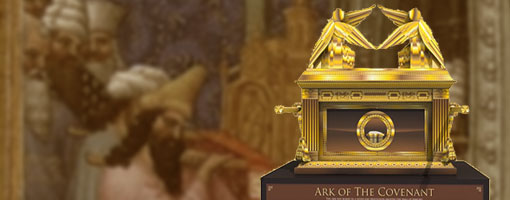
The Ark of the Covenant is described in the Bible as a sacred container, wherein rested the Tablets of stone containing the Ten Commandments as well as Aaron's rod and manna. According to the Biblical account, the Ark was built at the command of God, in accord with Moses' prophetic vision on Mount Sinai (Exodus 25:10-16). God communicated with Moses "from between the two cherubim" on the Ark's cover (Exodus 25:22). The Ark and its sanctuary were "the beauty of Israel" (Lamentations 2:1). Rashi and some Midrashim suggest that there were two arks - a temporary one made by Moses, and a later one made by Bezalel.
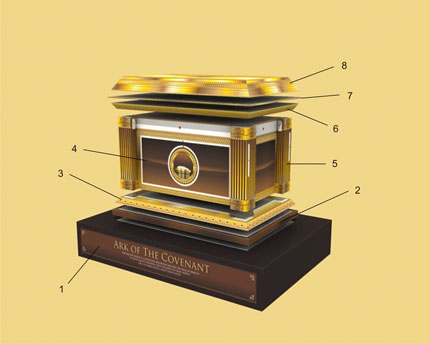
The Biblical account relates that during the trip of the Israelites, the Ark was carried by the priests ~2,000 cubits (Numbers 35:5; Joshua 4:5) in advance of the people and their army or host (Num. 4:5-6; 10:33-36; Psalms 68:1; 132:8). When the Ark was borne by priests into the bed of the Jordan, the river was separated, opening a pathway for the whole of the host to pass over (Josh. 3:15-16; 4:7-18). The Ark was borne in a seven-day procession around the wall of Jericho by seven priests sounding seven trumpets of rams' horns, the city taken with a shout (Josh. 6:4-20). When carried, the Ark was always wrapped in a veil, in tachash skins (the identity of this animal is uncertain), and a blue cloth, and was carefully concealed, even from the eyes of the Levites who carried it. [More at Wikipedia]
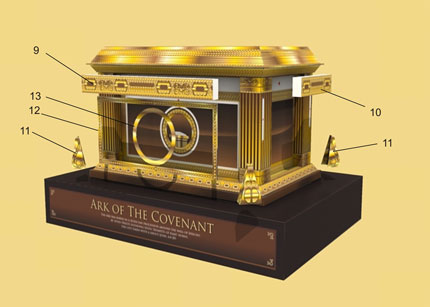
Terminology
The Hebrew word aron is used in the Bible to refer to any type of ark, chest or coffer, for any purpose (Book of Genesis 50:26; 2 Kings 12:9, 10).
The Ark of the Covenant is distinguished from all others by such titles as:
* Taboot fia Sakina Holy Quran ](Chapter 2 Al Bakra Verse 248)
* Holy Ark
* Ark of God, (1 Samuel 3:3)
* Ark of thy God's strength
* Ark of the Covenant, (Josh. 3:6; Hebrews 9:4)
* Ark of the Covenant of the Lord of all the Earth
* Ark of the Testimony, (Ex. 25:22) [More at Wikipedia]
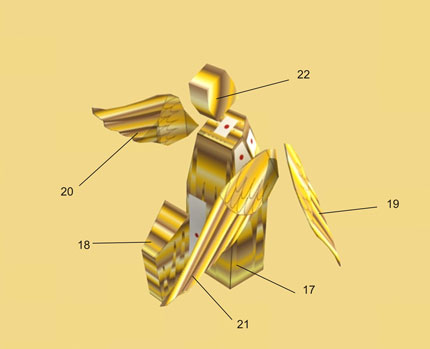
Description
The Bible describes the Ark as made of shittah-tree wood (acacia), known to the Egyptians as the Tree of Life and an important plant in traditional medicine containing in many cases psychoactive alkaloids. It was 1.5 cubits broad and high, and 2.5 cubits long, conforming to the golden ratio. (~130 x 78 x 78 cm or 4.27 x 2.56 x 2.56 ft, using the Egyptian royal cubit). The Ark was covered all over with the purest gold. Its upper surface or lid, the mercy seat (Hebrew: Kaporet), was surrounded with a rim of gold. [More at Wikipedia]

On each of the two long sides were two gold rings, wherein were placed two wooden poles (with a decorative sheathing of gold), to allow the Ark to be carried (Num. 7:9; 10:21; 4:5,19, 20; 1 Kings 8:3, 6). Over the Ark, at the two extremities, were two cherubim, with their faces turned toward one another (Leviticus 16:2; Num. 7:89). Their outspread wings over the top of the Ark formed the throne of God, while the Ark itself was his footstool (Ex. 25:10-22; 37:1-9). The Ark was placed in the "Holy of Holies," so that one end of the carrying poles touched the veil separating the two compartments of the tabernacle (1 Kings 8:8). The Book of Deuteronomy describes the Ark as a simple wooden container with no mention of ornaments or gold. Similarly, the Quran makes a reference to the Ark as a wooden box with holy relics inside it. [More at Wikipedia]
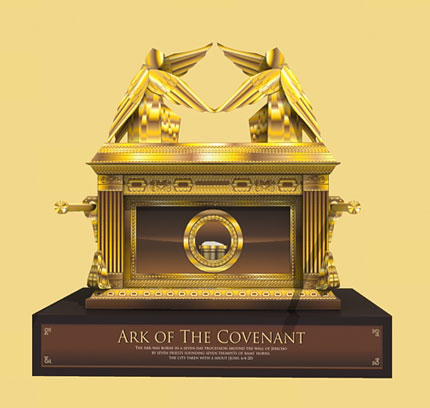
Contents
According to the Bible, the two tablets of stone constituting the "testimony" or evidence of God's covenant with the people (i.e. The Ten Commandments) were kept within the Ark itself. A golden jar containing some of the manna from the Israelites' trek in the wilderness, and the rod of Aaron that budded, were added to the contents of the Ark (Ex. 16:32-34; Heb. 9:4), but apparently were later removed at some point prior to the building of Solomon's temple, as I Kings 8:9 that there "was nothing in the Ark save the two tablets of stone." While Heb. 9:4 states these items were placed "inside" the Ark, Ex. 16:33-34 and Num. 17:10 use the expression "before" the Ark; some see a contradiction here, as the correct meaning of these phrases is open to interpretation. A Rabbinic tradition states that Moses also put the broken fragments of the first tablets of the Law into the Ark. Some scholars have argued that the plans to the Tabernacle were contained in the Ark. [More at Wikipedia]
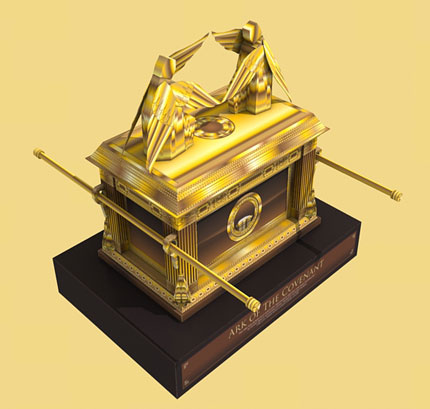
Sanctity and consecration
Even Aaron, brother of Moses and the High Priest, was forbidden to enter the place of the Ark, except once a year on a designated day, called The Day of Atonement, when he was to perform certain ceremonies there (Lev. 16). Moses was directed to consecrate the Ark, when completed, with the oil of holy ointment (Ex. 30:23-26); he was also directed to have the Ark made by Bezalel, son of Uri of the tribe of Judah, and by Aholiab, the son of Ahisamach of the tribe of Dan (Ex. 31:2-7). These instructions Moses carried out, calling upon every "wisehearted" one among the people to assist in the work (Ex. 35:10-12). Bezalel the artist made the Ark (Ex. 37:1); and Moses approved the work, put the testimony in the Ark, and installed it.
According to the Haggadah written in the Mishnaic and Talmudic periods (circa 200-500 AD), after installment in the second Temple, the Ark and the operation of the Temple was supervised by the angel Metatron. There are numerous possible etymologies for the name Metatron, one being from two Greek words μετὰ θρóνος after and throne. There are no references to Metatron in the Jewish Tanakh (Old Testament), the Christian Scriptures (New Testament) or any Islamic source.
In Deut. 10:1-5, a different account of the making of the Ark is given. Moses is made to say that he constructed the Ark before going upon Mount Horeb to receive the second set of tablets. The charge of carrying the Ark and the rest of the holy implements was given to the family of Kohath (of the tribe of Levi). They, though, were not to touch any of the holy things that were still uncovered by Aaron (Num. 4:2-15). [More at Wikipedia]
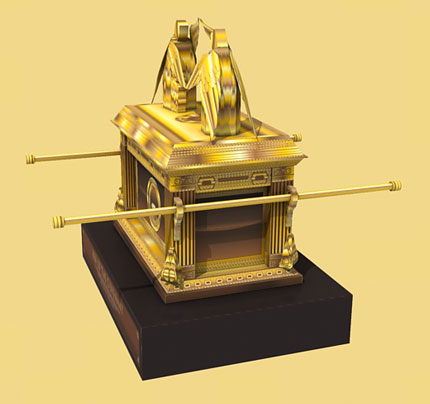
Other references to the Ark in Scripture
The Ark of the Covenant is mentioned in both the Bible and the Qur'an.
In the Bible
The Ark carried into the Temple
The Ark is mentioned in the books Joshua, Exodus, Deuteronomy,2 Samuel, Hebrews and Jeremiah. It is referenced by Jeremiah, who, speaking in the days of Josiah (Jer. 3:16), prophesies a future time when the Ark will no longer be used. In the Psalms, the Ark is twice referred to. In Ps. 78:61 its capture by the Philistines is spoken of, and the Ark is called "the strength and glory of God"; and in Ps. 132:8, it is spoken of as "You and the ark of Your strength." The Ark is also mentioned in several passages in Exodus and 1 Samuel, including Exodus 25:10-22 and 1 Samuel 4:3-22 and 5:7-8. The Ark is mentioned in one passage in the deuterocanonical 2 Maccabees 2:4-10, which contains a reference to a document saying that the prophet Jeremiah, "being warned of God," took the Ark, and the tabernacle, and the altar of incense, and buried them in a cave on Mount Nebo (Deut. 34:1), informing those of his followers who wished to find the place that it should remain unknown "until the time that God should gather His people again together, and receive them unto mercy." Hebrews 9:4 states that the Ark contained "the golden pot that had manna, and Aaron's rod that budded, and the tables of the covenant." Finally, in the Book of Revelation the Ark is described as being in the 'temple' of God in heaven (Rev. 11:19). The Ark is last seen in God's 'temple' just before a woman gives birth to the man child (Rev. 12:1-2), both stalked by a dragon and his angels cast to earth (Rev. 12:3-17).
In the Quran
In chapter 2 (Verse 248) children of Israel, at the time of Samuel and Saul, are given back 'Tabut E Sakina' (the box) which contains remnants of household of Musa and Harun carried by angels which confirms peace and reassurance for them from their Lord. [More at Wikipedia]
